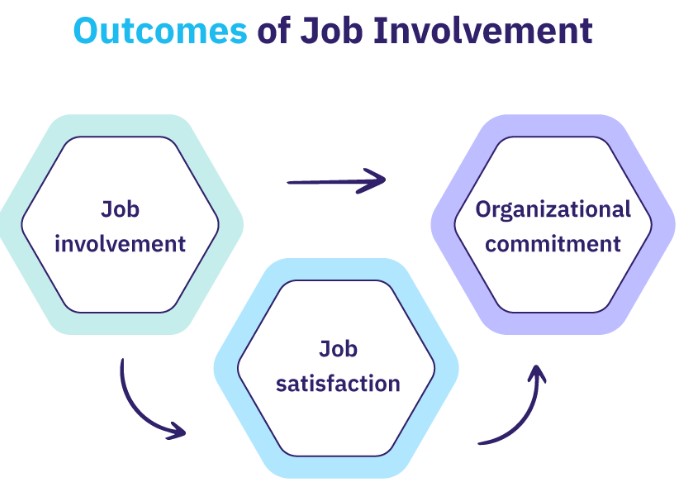Are you wondering what the difference is between job involvement and organizational commitment? This blog post will explain the difference between the two concepts and provide an overview of how they relate to each other.
Finally, we will look at the implications of each concept for the workplace.
Factors that affect job involvement and organizational commitment

The concept of job involvement and organizational commitment are often used together, however, these two terms have distinct differences. Job involvement is the degree of dedication and intensity of an individual’s participation in their job.
It is the level of engagement and enthusiasm for the job, and is closely related to the amount of effort put in by the individual. On the other hand, organizational commitment is the individual’s commitment to the organization in terms of dedication, loyalty and support. It is the individual’s connection to the organization, and the willingness to work towards its success.
There are various factors that affect job involvement and organizational commitment. These include job satisfaction, organizational culture, rewards, working environment, job security, and career development opportunities. Job satisfaction is important for job involvement, as it affects the individual’s level of engagement.
A positive working environment and culture can also have a positive effect on job involvement and organizational commitment. Rewards such as bonuses, promotions, and recognition can also affect job involvement and organizational commitment.
Job security and career development opportunities are also significant factors that can affect an individual’s job involvement and organizational commitment. Overall, job involvement and organizational commitment are two distinct concepts that can be affected by various factors. Understanding the differences between the two is key to understanding how to improve job involvement and organizational commitment in an organization.
How job involvement and organizational commitment impact business performance

Job involvement and organizational commitment are two key components of a successful business. Job involvement is a measure of how much an employee is invested in their work, and organizational commitment is a measure of how deeply they are committed to the success of the organization. While both of these traits are important for business performance, the difference between the two is significant.
While both of these traits are important for business performance, the difference between the two is significant. Job involvement is more focused on the individual’s contribution to the team, while organizational commitment is more focused on the overall goals of the organization. As such, organizations need to ensure that their employees have both job involvement and organizational commitment if they want to achieve the best performance.
Benefits of developing job involvement and organizational commitment

Job involvement and organizational commitment are two important concepts in the workplace. While they are closely related, there are distinct differences between the two.
Job involvement is the degree to which an employee is actively engaged in their work and is interested in understanding the purpose of their job. On the other hand, organizational commitment is an employee’s sense of loyalty and dedication to their employer and the organization as a whole. Developing both job involvement and organizational commitment can lead to numerous benefits, such as improved productivity, higher job satisfaction, and increased engagement.
By understanding the differences between job involvement and organizational commitment, employers can develop initiatives to foster both in order to create an optimal working environment.
Challenges to achieving job involvement and organizational commitment

Understanding the difference between job involvement and organizational commitment is key in achieving both. Job involvement refers to an employee’s engagement and dedication to their role and the tasks they perform. It involves a sense of ownership in the job and the pride an employee takes in their work.
On the other hand, organizational commitment is an employee’s dedication to the organization and its mission. It is an emotional attachment to the organization, which can lead to greater loyalty and job satisfaction.
The challenge is to understand that these two concepts are distinct, yet equally important in creating an engaged and motivated workforce.
Strategies for increasing job involvement and organizational commitment

Organizational commitment and job involvement are two distinct concepts, but they are closely related and often confused. Job involvement is defined as the degree to which an employee feels emotionally and cognitively connected to their job and the level of effort they are willing to put into it. Organizational commitment, on the other hand, is the degree to which an employee identifies with and is loyal to their organization.
Organizational commitment, on the other hand, is the degree to which an employee identifies with and is loyal to their organization. While these concepts are different, organizations can use strategies to increase both job involvement and organizational commitment. These include providing a meaningful purpose to employees, offering rewards and recognition, and promoting a culture of collaboration and communication.
By taking steps to increase job involvement and organizational commitment, employers can create a more engaged and productive workforce.
Bottom Line
In conclusion, job involvement and organizational commitment are two different concepts that can both be beneficial to an organization. Job involvement is a measure of how much an employee is invested in their individual job performance, while organizational commitment is a measure of how much an employee is invested in the organization as a whole. Job involvement can help to motivate employees to work harder and can lead to higher levels of job satisfaction, while organizational commitment is important for creating a strong organizational culture and a sense of belonging among employees.
Both are important for the success of any organization.
